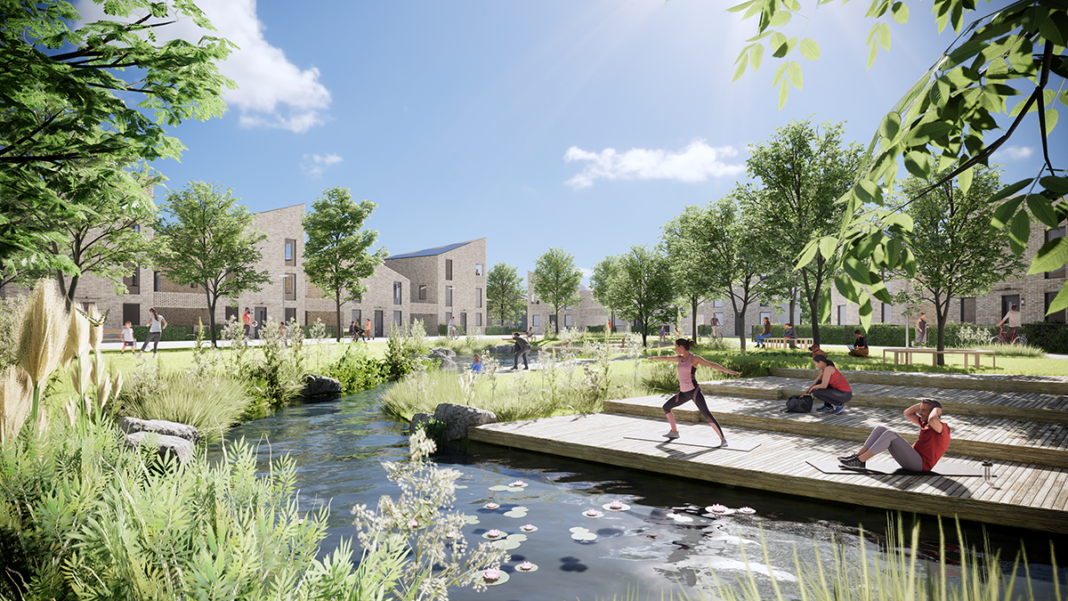
By Lesley Samuel, landscape architect at Halliday Fraser Munro
LANDSCAPE architecture, once an afterthought and often viewed as a hefty additional cost, is now moving to the forefront of many development plans. As attitudes change towards outdoor spaces there has been even greater traction around the impact landscape architecture has on our communities, mental health and the wider environment.
The World Health Organisation has recognised that urban green spaces, such as parks, playgrounds and residential greenery are found to ‘reduce morbidity and mortality in urban residents by providing psychological relaxation and stress alleviation, stimulating social cohesion, supporting physical activity, and reducing exposure to air pollutants, noise and excessive heat’.
As this understanding grows, developers are beginning to realise that incorporating more innovative approaches to the external spaces in their projects will add appeal both to householders and the increasing number of businesses that are prioritising the wellbeing of their employees. It can also assist with the planning process and ultimately make developments more attractive and marketable to people and businesses that are rapidly awakening to the need for sustainability and the value and importance of outdoor spaces.
Innovative landscape architecture can also address issues around climate change, biodiversity and the way in which communities connect. Latest research shows that the impact of climate change is already being felt in Scotland with estimates of around 13% more rain falling than 100 years ago.
The Scottish Government has stated that ‘flooding poses the greatest long-term risk to infrastructure performance from climate change’. To achieve resilience, it’s essential for us to keep the landscape as diverse as possible. This begins by incorporating natural resources and Sustainable Urban Drainage Systems (SUDS), which are now a critical part of any development plan.
Such systems help reduce runoff volumes and flow rates from hard surfaces, reducing the risk of flooding. While these issues can be contained by engineering underground tanks and pipework, more creative solutions using landscape designs can deploy more open watercourses to add interest to the urban landscape.

These will slow the speed of runoff – protecting the natural flow in rivers. Pollution from runoff and grey water can also be prevented by strategic planting of appropriate species. These promote biodiversity and enhance insect, bird, aquatic and other wildlife, all of which add interest and benefit the environment in which we live, work and play.
Covid-19 has had a marked effect on our individual awareness of the importance of our outdoor environment with The Landscape Institute proposing five principles to guide the UK Government in achieving a sustainable recovery from the pandemic. The need to use those green spaces closest to us to exercise, socialise and avoid public transport has heightened consciousness of the shortcomings of our immediate surroundings.
Similarly, as homeworking has burgeoned, awareness of surrounding green spaces (or lack of them) has grown and driven a dramatic rise in rural property values across the UK.
If, as is currently being suggested, homeworking continues to erode demand for office space, it’s natural to assume that those offices with the greenest and most sustainable landscape architecture will enjoy the healthiest demand.
With trees remaining the ultimate carbon capture in our environment we need to think of creative ways to incorporate trees, edible planting and species rich meadow grass into the built environment.
These facts are not being lost on local authorities who are adopting increasingly ambitious approaches to the outdoor environment in their local development plans.
Moray Council’s most recent plan illustrates just how seriously they are taking the issues of human and environmental wellbeing and developers will have to demonstrate greater sensitivity to these aspects of any proposals.
Securing planning permission will inevitably require more progressive thinking about a project’s response to its surroundings.
At Halliday Fraser Munro, we have worked closely with local authorities to improve the outdoor provision of Early Learning and Care centres. Educational psychologists have established the importance of incorporating natural experiences into the learning environment and the spaces we have designed, join seamlessly with the interior spaces. These exterior spaces were carefully designed to heighten the children’s tactile experience of nature with inspiring planting, water features and mud – all open for exploration.
Ultimately this all points to the need to make spaces in the built environment greener and more inspiring. The Coronavirus crisis has reminded us of the disruptive potential of the climate crisis and governments around the world are committing to a ‘green recovery’ and placing greater emphasis than ever on our environment.
Landscape architecture can play an integral part in helping governments achieve these new green goals with the style, nature and intensity of their designs.








